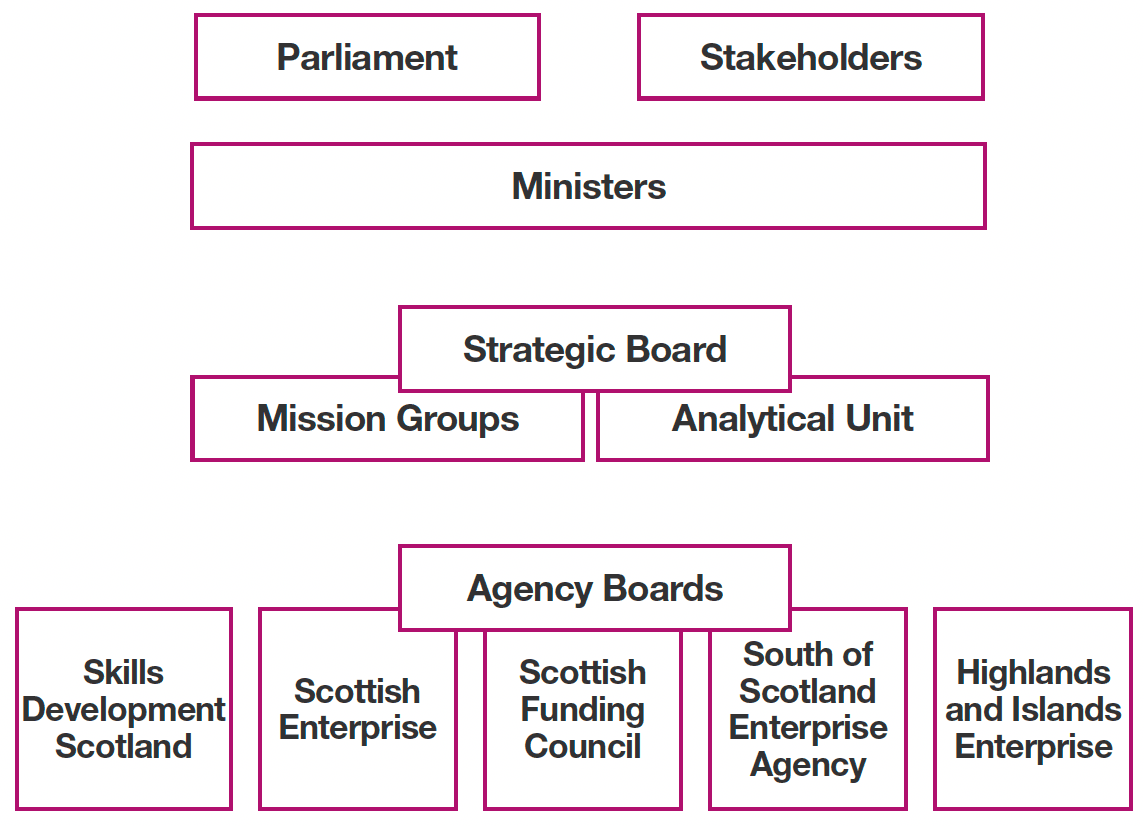Enterprise and Skills Strategic Board: key achievements and lessons
This publication covers the key achievements of the Enterprise and Skills Strategic Board (ESSB) and their lessons for enhancing delivery. This will help inform the National Strategic for Economic Transformation (NSET) Delivery Board.
2. Background on the Enterprise and Skills Strategic Board
The ESSB was established in November 2017 following a two-part review of the enterprise and skills landscape which looked at how Scotland's public agencies were delivering enterprise and skills support for Scotland's citizens – young people, women, universities, colleges, training providers, businesses and workers. Following phase one, Ministers were of the view that stronger governance was required and commissioned Prof Lorne Crerar to explore the creation of a single coherent system. Crerar's review 'Proposals on Governance and the Creation of a Strategic Board'[1] formed the governance workstream of phase two.
Led by Keith Brown, Cabinet Secretary for Economy, Jobs and Fair Work, and supported by a Ministerial Review Group, phase two of the review aimed to:
- significantly improve enterprise and skills support, to help Scotland progress towards achieving the aim of ranking among the top quartile of OECD countries in terms of productivity, equality, wellbeing and sustainability;
- be driven by evidence, to listen to the views of service users, and to put forward proposals that respond to their needs; and
- ensure a simpler and more coherent enterprise and skills support system.
As a result, the ESSB was created to drive alignment and coordinate activities across Scotland's enterprise and skills agencies: Scottish Enterprise (SE), Highlands and Islands Enterprise (HIE), Skills Development Scotland (SDS) and the Scottish Funding Council (SFC). South of Scotland Enterprise (SoSE) joined on its inception on 1 April 2020. Chaired by Nora Senior, Group Executive Chair Weber Shandwick and with membership spanning the agencies and key figures from business, academia, STUC and COSLA, the ESSB aimed to:
- improve the overall performance of the economy by ensuring that the whole enterprise and skills system delivers Scotland's Economic Strategy and supporting strategies, in all parts of Scotland;
- through collective responsibility ensure hard alignment between agencies to drive improvement in Scottish productivity and better support business and users of the skills system;
- hold agencies to account for performance against agreed measures;
- actively engage with other agencies and bodies who support the economy with a view to increasing alignment and challenge others where collaboration is not happening; and
- deliver wider collective leadership, based on common culture and values, and which inspires and empowers delivery.
The following diagram illustrates the governance arrangements.

Graphic text below:
Parliament
Stakeholders
Ministers
Strategic Board
- Mission Groups
- Analytical Unit
Agency Boards
- Strategic Board
- Skills Development Scotland
- Scottish Enterprise
- Scottish Funding Council
- South of Scotland Enterprise Agency
- Highlands and Islands Enterprise
In October 2018 the ESSB published its Strategic Plan 'Working Collaboratively for a Better Scotland'[2] – providing a blue print aimed at driving productivity and inclusive growth. It established four interconnected missions: Business Models and Workplace Innovation; Future Skills; Business Creation and Growth; and Exports. The plan set out 14 initial actions that the ESSB asked the agencies to undertake and that it would support them in progressing.
It also highlighted 18 recommendations to Scottish Ministers where it believed there was additional potential that sat out with the ESSB's immediate remit to approve. The goal was greater collaboration not just among the enterprise and skills agencies themselves, but across the whole system.
The ESSB examined the evidence base and found that innovation was a key driver of productivity. As such a review of innovation was carried out to better understand this complex landscape. Digital adoption was also a theme that was identified as a driver of economic growth – so the ESSB guided the agencies to ensure digital and technology skills were integral to all plans.
Contact
Email: NSETSecretariat@gov.scot
There is a problem
Thanks for your feedback